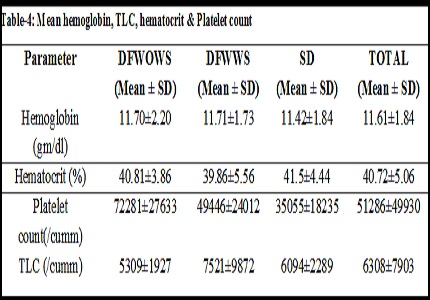A study of clinical, radio-imaging and biochemical profile of Dengue patients in relation with outcome in central Indian hospital
Abstract
Objective: Dengue fever is most important arbo-viral disease in India and other tropical and subtropical countries with increasing prevalence in recent years with significant morbidity and mortality. This study was aimed to evaluate clinical & hematological features and outcome in central Indian adult population.
Methods: A cross-sectional observational study undertaken among adult patients admitted in a teaching hospital. 105 patients were analyzed. All patients who were IgM-ELISA positive irrespective of their card test status were included in study. Clinical features and hematological, biochemical & radiological findings are noted.
Results: Total 105 dengue patients were included 22 ware of Dengue fever without warning signs (DFWOWS), 65 in Dengue fever with warning signs (DFWWS) and 18 were Severe Dengue (SD) group. Male: female ratio was 1.14:1. Most common age group affected was 21-30 Yrs. Most of cases reported in month of September and October. Clinical features noted most common was fever (96.2%); myalgia (57.1%), headache (40%), vomiting (24%), retro-orbital pain (26.6%), abdominal pain (26.6%), patechie (34.2%), rash (41.9%), and positive tourniquet test (56.1%). Major bleeding (25.7%), among them most common was gut bleeding. Complications were noted in SD group. Blood transfusion required in 43.8% cases. Coagulopathy was noted in 72.2% cases of DSS. No mortality was noted in our study.
Conclusion: Dengue is increased with increasing urbanization & poor sanitation. Dengue has wide spectrum of clinical and hematological presentation. Significant morbidity occurs in DHF and DSS. It is a low mortality illness if prompt diagnosis and proper fluid management instituted in DHF and DSS. Platelet transfusion has a little role in dengue management.
Downloads
References
WHO. Dengue and dengue hemorrhagic fever. Factsheet No17 revised May2008 [Internet]. Geneva, World Health Organization, 2008.[Cited on 2014 October 6].
Available from http://www.who.int/mediacentre/factsheets/fs117/en/.
World Health Organization. Comprehensive guidelines Prevention and control of dengue and dengue hemorrhagic fever [Internet]. New Delhi: WHO Regional publication, SEARO; No 29, 1999.[cited on 2014 September 30]
National Vector Borne Disease Control Program, Directorate General of Health Services, Ministry of health and family welfare; Dengue/DHF situation in India. http://www.Nvbdcp.gov.in
World health organization. Comprehensive guidelines for prevention and control of Dengue and Dengue Hemorrhagic Fever Revised and expanded edition[Internet]. Geneva: World health organization;2009. [cited on 2014 October 1]
World health organization Dengue: Guideline for diagnosis, treatment, prevention and control. Geneva: World health organization; 2009.[cited on 2014 September 30]
RachelDaniel, Rajamohanan and Aby Zachariah Philip, A Study of Clinical Profile of Dengue Fever in Kollam, Kerala, India, Dengue Bulletin. Vol 29, 2005.
Deshwal R, Qureshi MI, Singh R. Clinical and Laboratory Profile of Dengue Fever. J Assoc Physicians India. 2015 Dec;63(12):30-32.
Dr. Mohan D Kashinkunti, Dr. Shiddappa, Dr. Dhananjaya M.A Study of Clinical Profile of Dengue Fever in a Tertiary Care Teaching Hospital,Sch. J. App. Med. Sci., 2013; 1(4):280-282f In
Sanjay Kumar Mandal, Jacky Ganguly1, Koelina Sil1,clinical profiles of dengue fever in a teaching hospital of eastern India. National journal of medical research print ISSN: 2249 4995│eISSN: 2277 8810.
Amrita Roy, Debalina Sarkar, Sohini Chakraborty, Jasodhara Chaudhuri, Pramit Ghosh, and Swapna Chakraborty. Profileof Hepatic Involvement by Dengue Virus in Dengue Infected Children. Am J Med Sci. Aug 2013; 5(8): 480–485.



 OAI - Open Archives Initiative
OAI - Open Archives Initiative


